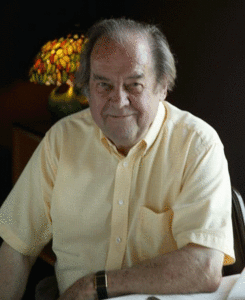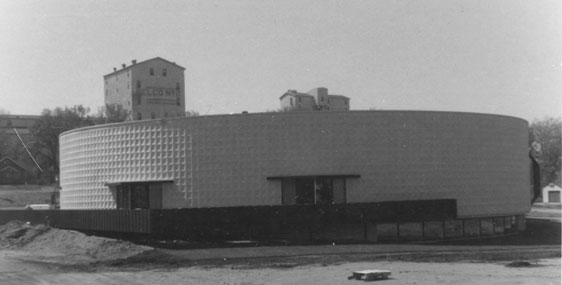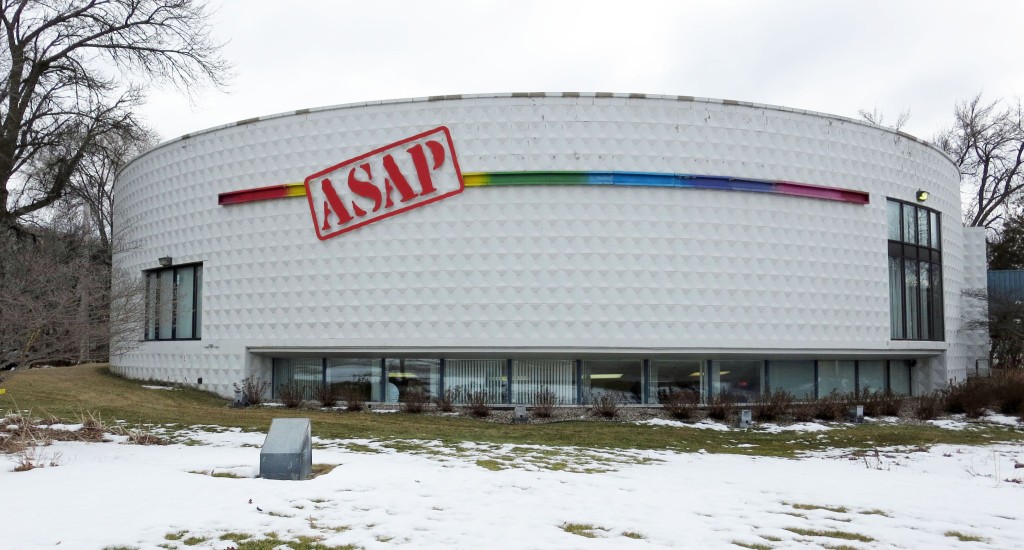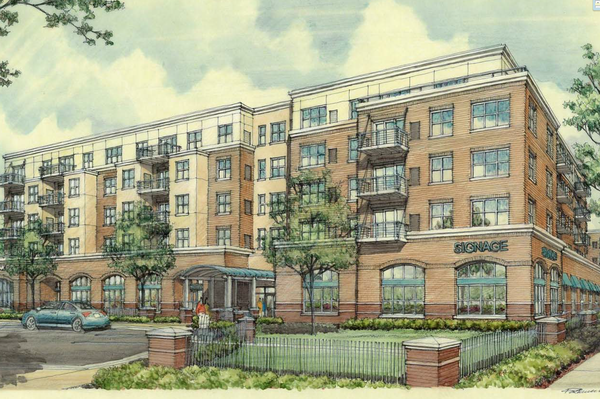This peculiar round building was built in 1963. It is unclear what was on this property beforehand, although the St. Louis Park Tax Assessor’s file has a picture of at least one house that had probably been demolished for the project.
Although the official address of the property is listed as 3907 County Road 25, it has always been identified as 3000 France Ave. by the owners.
Much of the information below was taken from the Documentation of Building History prepared by Preservation Design Works, LLC, in September 2015 for Bader Development in preparation for the building’s demolition. We thank Bader Development for sharing this document with the Historical Society.
ELLIOTT B. HOFFMAN
The building was commissioned by Elliott B. Hoffman (1912-1985). Hoffman is described by his sons as a man with vision, energy, and ideas. At age 17 he was a clerk for the Minneapolis Tribune. He graduated from the University of Minnesota in 1934 and worked as a salesman in 1936.
HOFFMAN-CALLAN PRINTING CO.
By 1938 he was the president of the Hoffman Letter and Printing Co. Sometime between 1942 and 1946 the name of the company became the Hoffman Printing Co.; it is unclear when he took on partner James Callan and the company became the Hoffman-Callan Printing Co. Its last Minneapolis location was at 1521 Hennepin Ave. Much of the company’s work was printing materials for law enforcement associations.
MOTOR TRAVEL SERVICES
In addition to the printing business, Hoffman also started Motor Travel Services, Inc., an alternative to AAA. The company published a document called the Certified Associated Restaurant Directory (CAR). A 1959 ad in Life Magazine described CAR as “a nationwide network of independently owned on-the-highway restaurants pledged to give you, the traveler, good food, convenience and services at popular “family” prices – your positive assurance of good eating for the entire family.” A 1962 ad places the company at 1521 Hennepin Ave. in Minneapolis and calls it “The New National MTS Auto Club.” Son Jay says that the organization was started because his father loved to travel. In fact, there were plans to build an adjoining motel, connected to the Hoffman-Callan Building with a skyway.
A NEW BUILDING
By 1946 Hoffman had moved his family to St. Louis Park, and when he needed a new facility for his businesses he cast his eye on the confluence of Minnetonka Blvd., Highway 7, and France Ave. Hoffman’s son Jay describes his father as a futuristic person who wanted something different in his new building. Hoffman and Callan considered several architects and decided to work with Prairie School architect James Dresser.
JAMES ROBERT DRESSER
James Robert Dresser had trained with Frank Lloyd Wright as a fellow at Taliesin from 1945-1947. Dresser designed “elegant and unique” buildings across the country, including the Minnesota Pavilion at the New York World’s Fair of 1964. In addition to this round building, Dresser also designed round homes.
From the Internet:
The building expresses the postwar modernist movement, which featured the use of new building materials and experimentation with form to create one-of-a-kind buildings. In particular, 1960s modern architecture was about the combination of “science and art.” This building displays characteristics of Modern architectural styles and the less formal postwar futurism as defined by striking shapes, dynamic lines, contrasts, and the use of advanced materials.

“THE ROUND BUILDING”
Hoffman-Callan employees referred to their new headquarters as “the round building,” although it did have a straight section that made it appear to be an unspooling roll of paper from the air. The building had two floors, with the printing facilities on the first floor. The second floor featured an atrium with skylights; the secretaries sat in the middle and the salesmen in offices around the perimeter. This very active area was referred to as “the bullpen.” A prominent figure in the company was production superintendent Leone Felcher, who had been with the company from the beginning and supervised 60 employees, 75 percent of whom were male. She was profiled in a series of Twin Cities residents by the Minneapolis Tribune in 1964.

The photo above was taken in the spring of 1963 by the City Tax Assessor’s office. The building had its grand opening in the fall of 1963. In the background, the Belco grain elevator is visible.
ST. LOUIS PARK FORUM
Another enterprise of Hoffman’s was the St. Louis Park Forum. This alternative to the St. Louis Park Dispatch newspaper was first published as a weekly in February 1965. Residents could subscribe to a full-sized issue, or read the free Forum Compact that was distributed in stores, etc. In May 1966 it went to a monthly publication and continued until December 1966.
After ten years, the building became impractical, especially for the printing end of the company. A one-story building was needed, and the company had to either expand or move. It eventually moved to Golden Valley in 1973.
Subsequent businesses in the building included:
Galaxy Film Service (1973-1976)
Maritz Laboratories (1976-1980)
Country Club Markets: In about 1980 the building was purchased by Country Club Markets, and the basement of the building (which extends under the parking lot) was filled with the company’s mainframe computer. Country Club went bankrupt in 1991.
ASAP
The ASAP Printing Co. moved into the building in 1991. From the company’s website:
As Soon As Possible is a graph production company that specializes in producing quick-hitting and short-run graphic art projects. It offers programs that utilize electronic prepress and digital and conventional printing, as well as large format graphics and web capabilities. The company also provides variable data print services and web publishing. In addition, As Soon As Possible offers offer banners, backlit displays, floor graphics, and trade show and presentation support services. It helps in scanning, assembling, coloring and correcting several Macintosh and Windows files. The company provides a variety of services related to Internet and photography. As Soon As Possible offers assistance with creative aspects of corporate identity and communication, direct marketing, and catalog and display.

THE SHOREHAM
In 2015 Bader Development, based in St. Louis Park, purchased the entire block that includes the ASAP building, with plans to demolish the existing buildings and build The Shoreham, a mixed-use complex similar to the Ellipse . It would have 150 residential units and 20,000 square feet of general- and medical-office uses on the first floor. Bader plans to move its own headquarters into the building. Minneapolis-based DJR Architecture designed the building.

